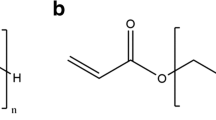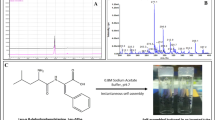Abstract
Tissue engineering requires novel smart materials to sustain cell growth, tissue regeneration and in situ drug release in a controlled mode. Also, biocompatible synthesis methods are needed to immobilize biologically active compounds. Poly(vinyl alcohol co-vinyl acetate) (PAcVA) was synthesized at 37 °C using glutaraldehyde (GA) as a crosslinking agent. The mechanical characteristics of the polymer were manipulated by varying crosslinking degrees using different GA concentrations. Materials with Young’s modules similar to soft tissues, adequate for tissue engineering, were obtained. PAcVA was a pH-responsive material with maximum swelling at pH 5.8. When hydrated, PAcVA was electro-responsive. Fluorescein was used as a model molecule to characterize the releasing properties of the polymer. Effective diffusivities were a function of the crosslinking degree. Release rates were proportional to temperature and were faster at lower GA contents. According to a fit to the Korsmeyer–Peppas’ model, diffusion at 5 and 10% GA was Fickian, but at 20% GA, diffusion was abnormal. To promote cell attachment and neutralize free aldehyde groups, PAcVA hydrogels were covered with poly-l-lysine and laminin, which supported growth of lung carcinoma and mouse hypothalamic cells without signs of cytotoxicity or oxidative stress. An intelligent low-cost hydrogel with properties that can be easily modulated was synthesized and fully characterized. Its properties make it suitable for tissue engineering applications, as they mimic the mechanical properties of natural tissues.









Similar content being viewed by others
References
Zhu J, Marchant RE (2011) Design properties of hydrogel tissue-engineering scaffolds. Exp Rev Med Dev 8:607–626. https://doi.org/10.1586/erd.11.27
El-Sherbiny I, Yacoub M (2013) Hydrogel scaffolds for tissue engineering: progress and challenges. Glob Cardiol Sci Pract 2013:316–342. https://doi.org/10.5339/gcsp.2013.38
Kohane DS, Langer R (2008) Polymeric biomaterials in tissue engineering. Pediatr Res 63:487–491. https://doi.org/10.1203/01.pdr.0000305937.26105.e7
Balint R, Cassidy NJ, Cartmell SH (2014) Conductive polymers: towards a smart biomaterial for tissue engineering. Acta Biomater 10:2341–2353. https://doi.org/10.1016/j.actbio.2014.02.015
Khan F, Tanaka M (2017) Designing smart biomaterials for tissue engineering. Int J Mol Sci 19:17. https://doi.org/10.3390/ijms19010017
Furth ME, Atala A, Van Dyke ME (2007) Smart biomaterials design for tissue engineering and regenerative medicine. Biomaterials 28:5068–5073. https://doi.org/10.1016/j.biomaterials.2007.07.042
Kumar A, Han SS (2017) PVA-based hydrogels for tissue engineering: a review. Int J Polym Mater Polym Biomater 66:159–182. https://doi.org/10.1080/00914037.2016.1190930
Rudra R, Kumar V, Kundu PP (2015) Acid catalysed cross-linking of poly vinyl alcohol (PVA) by glutaraldehyde: effect of crosslink density on the characteristics of PVA membranes used in single chambered microbial fuel cells. RSC Adv 5:83436–83447. https://doi.org/10.1039/C5RA16068E
Figueiredo KCS, Alves TLM, Borges CP (2009) Poly(vinyl alcohol) Films crosslinked by glutaraldehyde under mild conditions. J Appl Polym Sci 111:3074–3080. https://doi.org/10.1002/app.29263
Mansur HS, Sadahira CM, Souza AN, Mansur AAP (2008) FTIR spectroscopy characterization of poly (vinyl alcohol) hydrogel with different hydrolysis degree and chemically crosslinked with glutaraldehyde. Mater Sci Eng, C 28:539–548. https://doi.org/10.1016/j.msec.2007.10.088
Fumio U, Hiroshi Y, Kumiko N et al (1990) Swelling and mechanical properties of poly(vinyl alcohol) hydrogels. Int J Pharm 58:135–142. https://doi.org/10.1016/0378-5173(90)90251-X
Gohil JM, Bhattacharya A, Ray P (2006) Studies on the crosslinking of poly(vinyl alcohol). J Polym Res 13:161–169. https://doi.org/10.1007/s10965-005-9023-9
Zhang Y, Zhu PC, Edgren D (2010) Crosslinking reaction of poly(vinyl alcohol) with glyoxal. J Polym Res 17:725–730. https://doi.org/10.1007/s10965-009-9362-z
Teramoto N, Saitoh M, Kuroiwa J et al (2001) Morphology and mechanical properties of pullulan/poly(vinyl alcohol) blends crosslinked with glyoxal. J Appl Polym Sci 82:2273–2280. https://doi.org/10.1002/app.2075
Chen CT, Chang YJ, Chen MC, Tobolsky AV (1973) Formalized poly(vinyl alcohol) membranes for reverse osmosis. J Appl Polym Sci 17:789–796. https://doi.org/10.1002/app.1973.070170311
Jian S, Xiao Ming S (1987) Crosslinked PVA-PS thin-film composite membrane for reverse osmosis. Desalination 62:395–403. https://doi.org/10.1016/0011-9164(87)87040-6
Burshe MC, Sawant SB, Joshi JB, Pangarkar VG (1997) Sorption and permeation of binary water-alcohol systems through PVA membranes crosslinked with multifunctional crosslinking agents. Sep Purif Technol 12:145–156. https://doi.org/10.1016/S1383-5866(97)00042-7
Araujo AM, Neves MT Jr, Azevedo WM et al (1997) Polyvinyl alcohol-glutaraldehyde network as a support for protein immobilisation. Biotechnol Tech 11:67–70
Migneault I, Dartiguenave C, Bertrand MJ, Waldron KC (2004) Glutaraldehyde: behavior in aqueous solution, reaction with proteins, and application to enzyme crosslinking. Biotechniques 37:790–796
Kim KJ, Lee SB, Han NW (1994) Kinetics of crosslinking reaction of PVA membrane with glutaraldehyde. Korean J Chem Eng 11:41–47. https://doi.org/10.1007/BF02697513
Hassan CM, Peppas NA (2000) Structure and applications of poly(vinyl alcohol) hydrogels produced by conventional crosslinking or by freezing/thawing methods. In: BT—biopolymers · PVA hydrogels, anionic polymerisation nanocomposites. Springer, Berlin, pp 37–65
Antonietti M, Caruso RA, Göltner CG, Weissenberger MC (1999) Morphology variation of porous polymer gels by polymerization in lyotropic surfactant phases. Macromolecules 32:1383–1389. https://doi.org/10.1021/ma9812478
Ahearne M, Yang Y, El Haj AJ et al (2005) Characterizing the viscoelastic properties of thin hydrogel-based constructs for tissue engineering applications. J R Soc Interface 2:455–463. https://doi.org/10.1098/rsif.2005.0065
Liebschner M, Bucklen B, Wettergreen M (2005) Mechanical aspects of tissue engineering. Semin Plast Surg 19:217–228. https://doi.org/10.1055/s-2005-919717
Xia T, Liu W, Yang L (2017) A review of gradient stiffness hydrogels used in tissue engineering and regenerative medicine. J Biomed Mater Res, Part A 105:1799–1812. https://doi.org/10.1002/jbm.a.36034
Bas O, Catelas I, De-Juan-Pardo EM, Hutmacher DW (2018) The quest for mechanically and biologically functional soft biomaterials via soft network composites. Adv Drug Deliv Rev 132:214–234. https://doi.org/10.1016/j.addr.2018.07.015
Sonker AK, Rathore K, Nagarale RK, Verma V (2018) Crosslinking of polyvinyl alcohol (PVA) and effect of crosslinker shape (aliphatic and aromatic) thereof. J Polym Environ 26:1782–1794. https://doi.org/10.1007/s10924-017-1077-3
Peng Z, Li Z, Zhang F, Peng X (2012) Preparation and properties of polyvinyl alcohol/collagen hydrogel. J Macromol Sci Part B 51:1934–1941. https://doi.org/10.1080/00222348.2012.660060
Liang XLX, Boppart SA (2010) Biomechanical properties of in vivo human skin from dynamic optical coherence elastography. IEEE Trans Biomed Eng 57:953–959. https://doi.org/10.1109/TBME.2009.2033464
van Dommelen JAW, van der Sande TPJ, Hrapko M, Peters GWM (2010) Mechanical properties of brain tissue by indentation: Interregional variation. J Mech Behav Biomed Mater 3:158–166. https://doi.org/10.1016/j.jmbbm.2009.09.001
Soza G, Grosso R, Nimsky C et al (2005) Determination of the elasticity parameters of brain tissue with combined simulation and registration. Int J Med Robot 1:87–95. https://doi.org/10.1002/rcs.32
Wadhwa R, Lagenaur CF, Cui XT (2006) Electrochemically controlled release of dexamethasone from conducting polymer polypyrrole coated electrode. J Control Release 110:531–541. https://doi.org/10.1016/j.jconrel.2005.10.027
Kato Y, Ozawa S, Miyamoto C et al (2013) Acidic extracellular microenvironment and cancer. Cancer Cell Int 13:89. https://doi.org/10.1186/1475-2867-13-89
Muthukumar M, Edwards SF (1982) Screening concepts in polymer solution dynamics. Polymer (Guildf) 23:345–348. https://doi.org/10.1016/0032-3861(82)90333-0
Rusling JF, Suib SL (1994) Characterizing materials with cyclic voltammetry. Adv Mater 6:922–930. https://doi.org/10.1002/adma.19940061204
Daubinger P, Kieninger J, Unmüssig T, Urban G (2014) Electrochemical characteristics of nanostructured platinum electrodes—a cyclic voltammetry study. Phys Chem Chem Phys 16:8392–8399
Hille B (2001) Ion channel excitable membranes, 3rd edn. Sinauer Associates Inc, Sunderland, MA, pp 1–37
Mawad D, Odell R, Poole-Warren LA (2009) Network structure and macromolecular drug release from poly(vinyl alcohol) hydrogels fabricated via two crosslinking strategies. Int J Pharm 366:31–37. https://doi.org/10.1016/j.ijpharm.2008.08.038
Renkin EM (1954) Filtration, diffusion and molecular sieving through porous cellulose membranes. J Gen Physiol 38:225–243
Dash S, Murthy PN, Nath L, Chowdhury P (2010) Kinetic modeling on drug release from controlled drug delivery systems. Acta Pol Pharm 67:217–223
Siepmann J, Siepmann F (2008) Mathematical modeling of drug delivery. Int J Pharm 364:328–343. https://doi.org/10.1016/j.ijpharm.2008.09.004
Higuchi T (1963) Mechanism of sustained-action medication. Theoretical analysis of rate of release of solid drugs dispersed in solid matrices. J Pharm Sci 52:1145–1149. https://doi.org/10.1002/jps.2600521210
Korsmeyer RW, Gurny R, Doelker E et al (1983) Mechanisms of solute release from porous hydrophilic polymers. Int J Pharm 15:25–35. https://doi.org/10.1016/0378-5173(83)90064-9
Shamaeli E, Alizadeh N (2014) Nanostructured biocompatible thermal/electrical stimuli-responsive biopolymer-doped polypyrrole for controlled release of chlorpromazine: kinetics studies. Int J Pharm 472:327–338. https://doi.org/10.1016/j.ijpharm.2014.06.036
Ritger PL, Peppas NA (1987) A simple equation for description of solute release I. Fickian and non-Fickian release from non-swellable devices in the form of slabs, spheres, cylinders or discs. J Control Release 5:23–36. https://doi.org/10.1016/0168-3659(87)90034-4
Varshosaz J, Hajian M (2004) Characterization of drug release and diffusion mechanism through hydroxyethylmethacrylate/methacrylic acid pH-sensitive hydrogel. Drug Deliv 11:53–58. https://doi.org/10.1080/10717540490265298
LoPachin RM, Gavin T (2014) Molecular mechanisms of aldehyde toxicity: a chemical perspective. Chem Res Toxicol 27:1081–1091. https://doi.org/10.1021/tx5001046
Esterbauer H, Schaur RJ, Zollner H (1991) Chemistry and biochemistry of 4-hydroxynonenal, malonaldehyde and related aldehydes. Free Radic Biol Med 11:81–128. https://doi.org/10.1016/0891-5849(91)90192-6
Kehrer JP, Biswal SS (2000) The molecular effects of acrolein. Toxicol Sci 57:6–15
Gough JE, Scotchford CA, Downes S (2002) Cytotoxicity of glutaraldehyde crosslinked collagen/poly(vinyl alcohol) films is by the mechanism of apoptosis. J Biomed Mater Res 61:121–130. https://doi.org/10.1002/jbm.10145
Acknowledgements
Research performed thanks to the financial support of the Programa UNAM-DGAPA-PAPIIT IT-200416. F. Villanueva received a scholarship from CONACyT during her graduate studies. We thank Mariana Ramírez Gilly (Facultad de Química UNAM), Melina Tapia Tapia (Instituto de Química UNAM), Manuel Aguilar Franco (Laboratorio Central de Microscopía UNAM), Martha A. Contreras, Ruth Pastor, Vanessa Hernández, Guadalupe Zavala Padilla, Arturo Pimentel Cabrera and the National Laboratory of Advanced Microscopy (LNMA-IBT-UNAM) for technical support.
Author information
Authors and Affiliations
Corresponding author
Ethics declarations
Conflict of interest
The authors declare that they have no conflict of interest.
Additional information
Publisher's Note
Springer Nature remains neutral with regard to jurisdictional claims in published maps and institutional affiliations.
Electronic supplementary material
Below is the link to the electronic supplementary material.
10853_2019_3402_MOESM1_ESM.docx
Supplementary information (S): File S1. Detailed procedure to obtain Eq. 6, used to determine effective diffusivities of fluorescein across PAcVA films (DOCX 18 kb)
Rights and permissions
About this article
Cite this article
Villanueva-Flores, F., Miranda-Hernández, M., Flores-Flores, J.O. et al. Poly(vinyl alcohol co-vinyl acetate) as a novel scaffold for mammalian cell culture and controlled drug release. J Mater Sci 54, 7867–7882 (2019). https://doi.org/10.1007/s10853-019-03402-1
Received:
Accepted:
Published:
Issue Date:
DOI: https://doi.org/10.1007/s10853-019-03402-1




